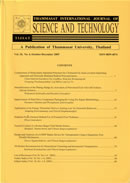ThaiScience
ThaiScience
THAMMASAT INTERNATIONAL JOURNAL OF SCIENCE & TECHNOLOGY
Volume 24, No. 04, Month OCTOBER, Year 2019, Pages 13 - 41
Forecast of rooftop pv adoption in thailand
Aksornchan Chaianong, Athikom Bangviwat, Christoph Menke
Abstract Download PDF
As the interest in rooftop photovoltaic (PV) systems has increased in Thailand, it is necessary to evaluate issues on grid integration and policy impacts. This study establishes a systematic approach to forecasting annual PV adoption that is necessary to analyze PV impacts of future actions in Thailand. A “Customer-adoption Model” was selected to forecast PV adoption until 2036. The payback period is the main indicator for addressing total PV adoption in 2036 and the Bass diffusion model is used to address annual PV adoption for four customer groups (residential scale, small general service, medium general service, and large general service). The two main parameters, buyback rate and PV installation cost reduction, are included to forecast PV adoption for eight scenarios. Under the assumption of a two percent annual PV cost reduction and no buyback rate, Thailand’s solar PV goal can be achieved in 2025, instead of 2036. Also, in 2036, PV is expected to constitute about 9%–14% of the energy basis of the overall system. Thai utilities should not only focus on total PV adoption but also consider annual PV adoption, since utilities need to prepare their power systems and staffs before hosting PV every year.
Keywords
PV adoption, Forecast; Rooftop PV, Solar PV, ThailandTHAMMASAT INTERNATIONAL JOURNAL OF SCIENCE & TECHNOLOGY
Published by : Thammasat University
Contributions welcome at : http://www.tijsat.tu.ac.th
